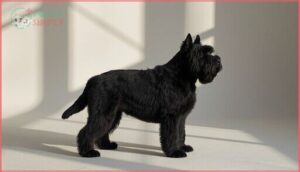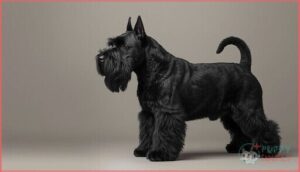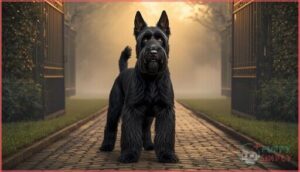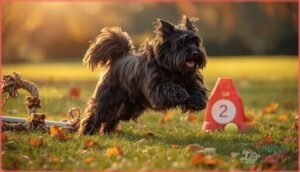This site is supported by our readers. We may earn a commission, at no cost to you, if you purchase through links.

The result was the Black Russian Terrier, a dog built like a tank and wrapped in a weather-proof coat. Standing up to 30 inches tall and weighing over 130 pounds, these dogs carry their military heritage in every powerful stride.
Their impressive size and natural protective instincts make them outstanding guardians, but they need experienced handlers who understand how to channel that working-dog drive into a well-adjusted family companion.
Table Of Contents
Key Takeaways
- The Black Russian Terrier was engineered by the Soviet military in the 1930s-40s from 17 breeds to create the ultimate guard dog that could handle extreme climates and demanding security work.
- These dogs aren’t for beginners—they need experienced handlers who can provide firm leadership, 60-90 minutes of daily exercise, and consistent training to channel their protective instincts properly.
- While they bond deeply with their families and can be excellent companions, their size (up to 130 pounds), protective nature, and independent streak require careful socialization starting before 18 weeks old.
- Owning this breed means committing to intensive grooming every 2-3 days, managing potential health issues like hip dysplasia and bloat, and investing $1,800-$4,000 upfront plus ongoing veterinary costs.
Black Russian Terrier Breed Overview
The Black Russian Terrier stands out as one of the most formidable working breeds you’ll encounter. This powerful dog was intentionally created in Russia during the 1930s to serve as a military guard and protection dog.
Understanding where this breed came from, how it was developed, and its journey to recognition will help you appreciate what makes these dogs tick.
Origin and History
During the late 1940s, the Soviet Union’s Red Star Kennel created the Black Russian Terrier through a strategic breeding program. You’ll find this breed’s genetic makeup includes about 17 founding breeds—primarily Giant Schnauzer, Airedale Terrier, and Rottweiler—each contributing specific traits.
The Soviet Union’s Red Star Kennel engineered the Black Russian Terrier from 17 breeds, blending Giant Schnauzer, Airedale, and Rottweiler genetics
After exclusive military use, civilian breed spread began in 1957, expanding the breed’s genetic diversity today. The American Kennel Club officially recognized this unique dog breed in 2004. The breed was developed to serve as a versatile military dog.
Breed Purpose and Development
The Soviet army needed a reliable guard dog that could handle extreme temperatures and demanding military work. That’s why Red Star Kennel’s breeding program focused on selecting specific working traits—courage, intelligence, and physical endurance.
They combined genetics from Giant Schnauzers, Rottweilers, and other breeds to create dogs capable of border patrol, prison security, and detection tasks across climates from Siberia to Central Asia. The breed’s development by Red Star Kennel occurred after WWII.
Recognition and Popularity
The Soviet breeding program succeeded—but it took decades for international kennel clubs to officially recognize the Black Russian Terrier as a distinct dog breed. The FCI accepted the breed in 1984, followed by the UKC in 1995 and AKC recognition in July 2004.
Despite this official dog breed information status, the Black Russian Terrier ranked 128th in 2024 AKC breed rankings. Registration trends and show participation remain modest, with public awareness concentrated mainly among working dog enthusiasts rather than general pet owners seeking dog breed popularity.
Physical Characteristics and Appearance
The Black Russian Terrier is a commanding presence that turns heads wherever it goes.
This breed’s physical build reflects its history as a working guard dog, combining power with surprising agility.
Let’s break down the key physical traits that define this impressive canine.
Size and Weight
The Black Russian Terrier is a powerhouse among dog breeds, with males generally standing 27 to 30 inches tall and weighing 110 to 132 pounds at maturity. Females are slightly smaller at 26 to 29 inches and 99 to 114 pounds. Understanding these breed standards helps you prepare for your dog’s growth stages:
- Male vs. Female differences: Males grow larger and heavier, reaching full size by 30 to 36 months
- Ideal weight range: Adults maintain 80 to 130 pounds depending on gender and build
- Size variability: Some individuals exceed 140 pounds, though breed standards favor proportional substance
Dog size and dog weight depend on genetics and proper nutrition during development.
Coat Type and Color
Your Black Russian Terrier’s double coat features a coarse, bristly outercoat and a dense, soft undercoat that work together for insulation and weather protection. The breed standard accepts only black coloring, backed by strict coat genetics testing.
Color variations like sable or silver occasionally appear but disqualify dogs from competition.
This low-shedding coat requires grooming two to three times weekly to prevent matting and maintain its functional structure.
Distinctive Features
Your Black Russian Terrier’s distinctive facial structure sets it apart—a squared-off muzzle shaped by thick whiskers and beard, dark oval eyes set wide for keen peripheral vision, and triangular ears pressed close to the cheekbones.
The muscular build extends from a powerful neck to large, rounded feet with thick pads. Breed proportions maintain a nearly square body, while tail carriage sits high at roughly 45 degrees, completing this commanding dog’s imposing silhouette.
Temperament and Personality Traits
Black Russian Terriers were bred to be guardians first and foremost, so their personality reflects that serious working heritage. Understanding their temperament helps you decide if this breed fits your household and lifestyle.
Let’s look at the key traits that shape how these dogs interact with their families, strangers, and other animals.
Protective Instincts
Your Black Russian Terrier isn’t just a pet—this breed ranks among the top protective dog breeds developed specifically for guard dog duties. Understanding their canine protective instincts helps you leverage these powerful traits safely.
Key aspects of their dog temperament and behavior include:
- Guarding Onset: Protective instincts generally emerge between 12 and 18 months, with 90% showing increased alertness by their first year.
- Threat Assessment: These dogs prioritize defending you over property, exhibiting heightened vigilance around strangers in 95% of cases.
- Genetic Basis: Bred from seventeen breeds in Soviet military programs, they carry markers for territoriality and defensive responses.
- Training Impact: Positive reinforcement reduces misdirected guarding by 75%, while early socialization prevents overprotective tendencies.
Their heritage as working protectors means your Black Russian Terrier takes security seriously. With proper guidance starting at three months, you’ll channel their natural drive into controlled responses rather than reactive aggression.
Companion Safety benefits are real—93% of families report feeling safer thanks to their dog’s deterrent presence, with response times averaging just 2-3 seconds when threats appear.
Family Compatibility
Your family interactions matter with this protective breed. Over 90% of Black Russian Terriers bond deeply with their household, displaying strong affection levels and “shadow” behavior.
Family dog suitability improves dramatically—72%—when you start dog socialization before 18 weeks. Child supervision remains essential due to their size, yet 85% demonstrate reliable safety considerations with proper training.
Their routine adaptability thrives when you introduce changes gradually, reducing stress behaviors by 61%.
Interaction With Other Pets
Bringing other pets into your Black Russian Terrier’s world requires strategic planning. Early socialization before six months reduces aggression by 44%, making multi-pet homes far more successful.
Your compatibility rates vary considerably by species:
- Dogs: 68% success with proper introductions and dog socialization
- Cats: 61% compatibility with structured training
- Small mammals: Below 15% due to moderate prey drive
- Pocket pets: Experts recommend avoiding this pairing
Supervised interactions cut incidents by 73%, while your dominant dog temperament means ongoing management protects household harmony.
Care, Exercise, and Training Needs
Black Russian Terriers aren’t couch potatoes, and they need owners who understand what it takes to keep these powerful dogs happy and well-behaved. Between their daily exercise needs, training requirements, and sharp minds that crave challenges, you’ll want to be prepared for an active partnership.
Here’s what you need to know about meeting your Black Russian Terrier’s physical and mental needs.
Daily Exercise Requirements
Ever notice how restless your dog gets after a missed walk? Black Russian Terrier exercise isn’t optional—it’s the backbone of your routine. Aim for 60–90 minutes daily, split between walks, fetch, or swimming.
Mix up activities to keep things fresh. Strong mental stimulation and the right frequency structure help meet their exercise needs and prevent anxious or destructive behaviors.
Training Methods and Socialization
Physical activity prepares your Black Russian Terrier, but training and socialization build the dog you want to live with. Early socialization—starting at 8 weeks—reduces fear-based issues by 72%.
Use positive reinforcement like treats and praise; it boosts obedience responses by 79%. Short, 10–15 minute sessions keep their intelligent minds engaged.
Firm leadership paired with correction protocols prevents pushiness, while puppy training with varied animals and environments builds confidence that lasts.
Mental Stimulation and Activities
Mental stimulation prevents boredom signs like pacing and chewing in your Black Russian Terrier. Without it, you’ll see a 55% spike in destructive behaviors. Keep that intelligent mind sharp with:
- Puzzle toys and scent work sessions three times weekly
- Canine sports like agility or trick training for structured engagement
- Sophisticated dog activities combining physical and mental challenges
Regular brain games cut stress-related health issues by 40%.
Health, Nutrition, and Grooming
Keeping your Black Russian Terrier healthy and looking their best takes some know-how. These dogs face a few breed-specific health concerns, need the right nutrition to fuel their large frames, and require regular grooming to maintain that signature coat.
Let’s break down what you need to know about their physical care, from common health issues to grooming essentials.
Common Health Issues
Black Russian Terrier health challenges deserve your attention. Hip dysplasia affects roughly 15% of the breed, while elbow dysplasia impacts about 10%. Genetic testing helps identify carriers of serious conditions like hyperuricosuria, which causes urinary stones in 27% of dogs with high uric acid. Progressive retinal atrophy leads to vision loss, and bloat prevention matters with their deep chests.
| Health Issue | Prevalence | Key Prevention Strategy |
|---|---|---|
| Hip Dysplasia | ~15% of breed | Early screening, controlled exercise |
| Hyperuricosuria | 27% high uric acid | Genetic testing before breeding |
| Elbow Dysplasia | ~10% of breed | Weight management, joint monitoring |
| Progressive Retinal Atrophy | Variable | Annual eye examinations |
| Bloat (GDV) | High risk | Multiple small meals daily |
Diet and Nutritional Needs
Your Black Russian Terrier’s nutrition directly impacts their health and energy. Here’s what you need to know about their diet requirements:
- Caloric intake: Feed 2200-2500 kcal daily for a 100-pound adult
- Protein ratios: Choose food with 22-26% protein for muscle maintenance
- Feeding schedule: Split meals twice daily to prevent bloat
- Hydration needs: Always provide fresh water
- Supplements: Consider glucosamine for joint support
Measure portions carefully to avoid obesity.
Grooming and Coat Maintenance
With a thick double coat that can quickly turn into a matted mess, your Black Russian Terrier needs consistent coat care.
Brush 2–3 times weekly using a slicker brush and comb, focusing on problem areas like behind the ears. Schedule professional grooming every 6–8 weeks for trimming. Bathe every 4–6 weeks with mild shampoo.
Proper Black Russian Terrier grooming prevents skin issues and keeps your dog comfortable.
Lifespan and Veterinary Care
Expect your Black Russian Terrier to live 10–12 years with proper care. Schedule annual veterinary visits for preventive care, and invest in genetic screening for hip dysplasia and JLPP before breeding.
As your dog reaches 7–8 years, increase wellness checks to catch common dog health problems early. Veterinary costs average $200–$400 yearly, with screening tests adding $150–$300 each.
Frequently Asked Questions (FAQs)
How much do Black Russian Terrier puppies cost?
Puppies from this breed generally range from $1,800 to $4,000, depending on lineage costs and breeder reputation. Health testing, regional pricing, and import fees can push that number higher for champion bloodlines.
Are Black Russian Terriers good with young children?
With proper socialization and training, they can be excellent family pets. Their protective instincts and calm temperament work well with older children, though supervised interactions remain essential for responsible ownership and child-safe socialization.
Are Black Russian Terriers easy to potty train?
Housebreaking these intelligent, independent dogs requires patience and firm leadership. Their quick learning ability makes training feasible, but stubbornness can slow progress.
Consistent crate training, scheduled outings, and positive reinforcement deliver the best results.
How much does a Black Russian Terrier puppy cost?
You’ll pay between $1,000 and $2,500 for Black Russian Terrier puppies from ethical breeders, with some reaching $4,
Breeder reputation, geographic location, pedigree quality, and included services like health clearances drive these price differences.
Can Black Russian Terriers live in hot climates?
Dogs with thick double coats aren’t built for scorching heat. Black Russian Terriers can adapt to warmer climates, but you’ll need to monitor heatstroke symptoms, manage indoor temperature carefully, provide outdoor shelter, and use cooling strategies like coat thermoregulation through proper grooming.
What are common behavioral problems in this breed?
Without proper socialization and training, Black Russian Terriers can develop aggression, separation anxiety, and stubbornness. Their protective temperament demands early socialization, consistent training, and daily mental stimulation to prevent destructive behaviors.
Conclusion
Not all heroes wear capes—some wear thick black coats and stand guard over the people they love. The Black Russian Terrier isn’t for everyone, but in the right hands, this breed transforms from a military marvel into a devoted family protector.
If you’re ready to invest the time, energy, and leadership these powerful dogs demand, you’ll gain a guardian who’s equal parts muscle and heart.
- https://dogtime.com/dog-breeds/black-russian-terrier
- https://www.webmd.com/pets/dogs/what-to-know-black-russian-terriers
- https://en.wikipedia.org/wiki/Black_Russian_Terrier
- https://www.petscare.com/news/faq/are-black-russian-terriers-rare-2
- https://rbtclub.uk/health--welfare/russian-black-terrier_bhcp.pdf












